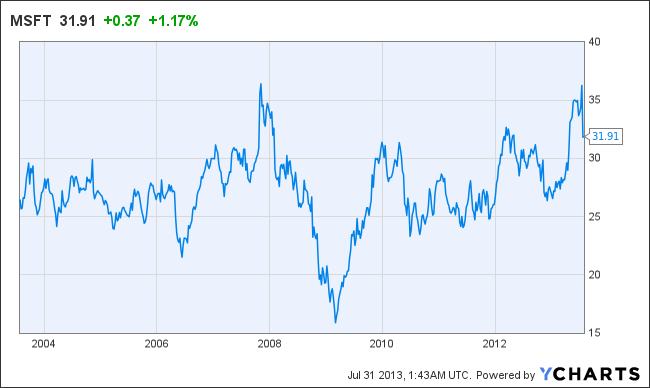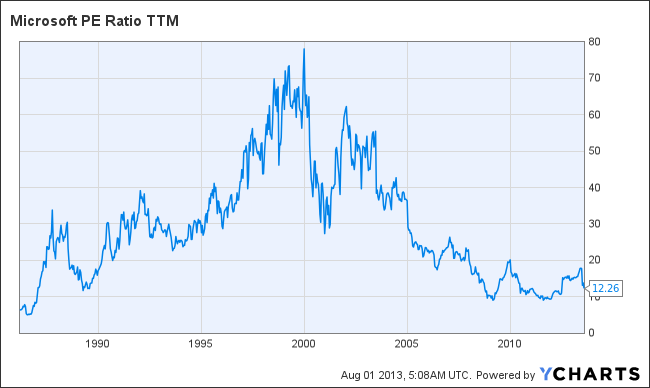Billionaire David Einhorn is apparently making an exit from Microsoft Corporation (NASDAQ:MSFT) at just the same time that Jeffrey Ubben’s ValueACT Capital is betting big on the tech giant. At the end of 1Q, Einhorn and his billion-dollar hedge fund, Greenlight Capital, owned just over 6 million Microsoft shares.
Einhorn notes that he and Greenlight took the boost in stock price that Microsoft Corporation (NASDAQ:MSFT) got from the ValueACT news to sell its stake in the tech giant, noting in his 2Q investor letter that…

The problem with Microsoft Corporation (NASDAQ:MSFT) from an investment standpoint? Over the last 10 years, the stock has traded in a tight range between $16 and $36, climbing only 20% for the decade…
ValueACT hopes to change this. During 1Q, ValueACT bought up over 33 million Microsoft Corporation (NASDAQ:MSFT) shares. The fund is now pushing for board representation and hoping to put together a succession plan for Steve Balmer. The other thing ValueACT could be pushing for includes putting Microsoft’s $75 billion in cash to work for shareholders.
Microsoft Corporation (NASDAQ:MSFT) is at an inflection point, with the company being at a crossroads thanks to its vast exposure to the declining PC market, where about 50% of its revenue is related and where Microsoft remains the dominant player in PC operating systems.
Even still, revenue is expected to be up 5.6% in fiscal 2014 and 6.1% 2015. Microsoft also has the upcoming release of its new video-game console, Xbox One, which should give interim revenue a boost while the company figures out other areas of its business model.
For a company in transition mode, it’s still trading at all-time highs, however, the stock is trading at 1990 levels on a P/E basis…
…so by historical standards it could still be considered cheap.
The tech company is moving from computing to devices (i.e. mobile and tablets) and services. However, its foray into the table market has not proven all that successful. Last month, the tech company had to reduce prices of its Surface tablets; moving its Surface RT 32GB version to $349 from $499 and the Surface RT 64GB version to $499 from $649.
To help put in perspective just how far behind Microsoft is in the tablet market, let’s compare it to tablet-leader Apple Inc. (NASDAQ:AAPL). IDC reported that for the first quarter, Microsoft sold 900,000 tablets compared to Apple’s 19.5 million, over 20 times that of Microsoft.
Big blue better?
Could International Business Machines Corp. (NYSE:IBM), aka Big Blue, be a better bet in the tech field? The company operates in the high-margin software and services part of the tech market. The tech giant also enjoys a return on equity in excess of 80% and return on invested capital in excess of 30%, well above Microsoft or Apple Inc. (NASDAQ:AAPL).
IBM has a diverse product portfolio, having been awarded 6,478 patents in 2012, more than any other company for the 20th straight year. International Business Machines Corp. (NYSE:IBM) also has operations in over 170 countries.
Last month, the company posted solid EPS results. Second-quarter EPS came in at $3.91 compared to $3.51 for the same period last year. But the numbers get better than just growing EPS. Operating margins expanded and Big Blue revised full-year guidance upwards; both moves were attributable to its greater focus on higher growth markets. IBM also pays a near 2% dividend yield and trades just under 14 times earnings.
What about the pioneer?
There’s no doubt that Apple has paved the way in both mobile and tablets, forcing many other providers to hold themselves to a higher standard. But the real problem with Apple’s business model is that it must innovate to grow.
Despite being the tablet leader, the market is heating up; competition now includes the likes of Hewlett-Packard, Barnes & Noble and Amazon. Apple saw continued weakness last quarter, with the tech giant posting EPS of $7.47 compared to $9.32 for the same period last year.
After the 3Q results, Morgan Stanley reiterated its overweight rating, noting that a big positive was the flat gross margin guidance, where the company generally sees margin compression during product-transition periods. The firm maintained its $540 price target.
Bottom line
Einhorn made a timely exit form Microsoft, while the stock was up nicely on the news that ValueACT was starting a campaign. Microsoft still pays a 2.9% dividend yield and appears cheap. The real issue going forward will be whether Microsoft can navigate the changing industry.
I like Microsoft’s chances, given ValueACT’s track record at Adobe. I also like IBM given its exposure to the high-margin services side of the tech industry. However, I’m still not convinced that Apple can continue innovating enough to return to its $700 price tag.
Marshall Hargrave has no position in any stocks mentioned. The Motley Fool recommends Apple. The Motley Fool owns shares of Apple, International Business Machines., and Microsoft.
The article Same Story, Different Decade for This Tech Giant originally appeared on Fool.com and is written by Marshall Hargrave.
Marshall is a member of The Motley Fool Blog Network — entries represent the personal opinion of the blogger and are not formally edited.
Copyright © 1995 – 2013 The Motley Fool, LLC. All rights reserved. The Motley Fool has a disclosure policy.







